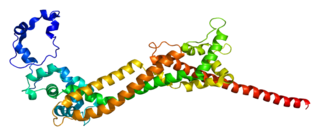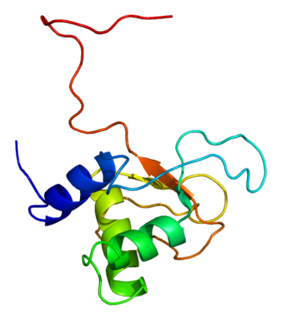
Drebrin is a protein that in humans is encoded by the DBN1 gene.

Ena/VASP-like protein is a member of the Ena/VASP family of proteins that in humans is encoded by the EVL gene.

Wiskott-Aldrich syndrome protein family member 3 is a protein that in humans is encoded by the WASF3 gene.

TRIO and F-actin-binding protein is a protein that in humans is encoded by the TRIOBP gene.

Scinderin is a protein that in humans is encoded by the SCIN gene. Scinderin is an actin severing protein belonging to the gelsolin superfamily. It was discovered in Dr. Trifaro's laboratory at the University of Ottawa, Canada. Secretory tissues are rich in scinderin. In these tissues scinderin, a calcium dependent protein, regulates cortical actin networks. Normally secretory vesicles are excluded from release sites on the plasma membrane by the presence of a cortical actin filament network. During cell stimulation, calcium channels open allowing calcium ions to enter the secretory cell. Increase in intracellular calcium activates scinderin with the consequent actin filament severing and local dissociation of actin filament networks. This allows the movement of secretory vesicles to release sites on the plasma membrane.

Multiple inositol polyphosphate phosphatase 1 is an enzyme that in humans is encoded by the MINPP1 gene.

39S ribosomal protein L15, mitochondrial is a protein that in humans is encoded by the MRPL15 gene.

Disheveled-associated activator of morphogenesis 1 is a protein that in humans is encoded by the DAAM1 gene. Evidence of alternative splicing has been observed for this gene but the full-length nature of these variants has not been determined.

39S ribosomal protein L18, mitochondrial is a protein that in humans is encoded by the MRPL18 gene.

39S ribosomal protein L22, mitochondrial is a protein that in humans is encoded by the MRPL22 gene.

Tyrosine-protein kinase STYK1 is an enzyme that in humans is encoded by the STYK1 gene.

39S ribosomal protein L1, mitochondrial is a protein that in humans is encoded by the MRPL1 gene.

Apolipoprotein L6 is a protein that in humans is encoded by the APOL6 gene.

FERM, RhoGEF and pleckstrin domain-containing protein 1 is a protein that in humans is encoded by the FARP1 gene.

MAGUK p55 subfamily member 2 is a protein that in humans is encoded by the MPP2 gene.

39S ribosomal protein L4, mitochondrial is a protein that in humans is encoded by the MRPL4 gene.

Sperm flagellar protein 1 is a protein that in humans is encoded by the SPEF1 gene.

Pleckstrin-2 is a protein that in humans is encoded by the PLEK2 gene. The PLEK2 gene is located on chromosome 14 in Homo sapiens and is flanked by TMEM229B to its right and ATP6V1D to its left.

39S ribosomal protein L17, mitochondrial is a protein that in humans is encoded by the MRPL17 gene.

Tropomodulin 2 (neuronal) also known as TMOD2 is a protein which in humans is encoded by the TMOD2 gene.



















